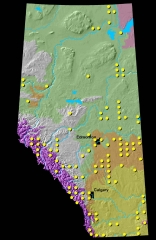Star-flowered Solomon’s Seal
Maianthemum stellatum – The species name, stellata, means “star-like” and describes the white flowers.
Other names
- In Latin: Maianthemum stellatum L. Link (also called Smilacina stellata (L.) Desf.)
- In English: Solomon plume, wild spikenard
- In French: smilacine à grappes
Taxonomy
Lily Family (Liliaceae)
Description
This herb has erect, often curved, stems 15 cm to 60 cm long.
- Leaves: Leaves are 2.5 cm to 12 cm long, light green, and have prominent parallel veins. The size and shape of the leaves are very variable depending on where the plant is growing. In bright light plants can be short and leaves are stiff, whereas in shade plants are tall and leaves are limp and large.
- Flowers: Flowers, up to 6 mm wide, are white and star-shaped (have six petals). The flowers form a loose group at the end of a leafy stem.
- Fruit: Berries are greenish with dark stripes, then turn red, then nearly black in early fall.
Distribution
Widespread throughout most of Alberta, but less common north of Lesser Slave Lake.
Habitat
Star-flowered Solomon’s seal grows in woodlands, open meadows, and shores of sandy marshes.
How to Observe
- If the plants are very abundant, mark a plot about one metre by one metre in size.
- Record these dates:
- First bloom: When the first flowers are open in the patch observed.
- Mid bloom: When approximately half (50%) of the flowers on the plants under observation are open.
When does this plant bloom?
Flowers in May to early June.
Life Cycle
This plant spreads by its creeping rhizomes. By the time these plants have died down in the fall, more than enough food has been manufactured and stored in the underground stem to ensure the development of a new lot of leafy stems next spring.
Ecology
Bears are very fond of these berries and livestock readily graze on the plants.
The sepals of the star-flowered Solomon’s seal flower are nearly horizontal. This position makes it easy for specialized insects to get at the nectar and pollen.
Human Uses
The berries were eaten by some First Nations tribes, but they are sickly sweet and were not highly prized.
Some First Nations burned the root as a smudge to quiet a crying child and to return someone to normal after temporary insanity. The powdered root was reportedly applied to wounds to help in the clotting of blood. They also used the root with food “during the time of plague to prevent sickness”. The plant was also mixed with other plants for use medicinally.
References
Cormack, R. G. G. 1977. Wildflowers of Alberta. Hurtig Publishers. Edmonton, Alberta.
Kindscher, K. 1992. Medicinal Wild Plants of the Prairie: An Ethnobotanical Guide. University Press of Kansas. Lawrence, Kansas.
Marles, R. J. et al. 2000. Aboriginal plant use in Canada’s Northwest Boreal Forest. Natural Resources Canada. UBC Press. Vancouver, British Columbia.
Moss, E. H. 1983. Flora of Alberta. 2nd edition. University of Toronto Press. Toronto, Ontario.
Scotter, G. W., H. Flygare. 1986. Wildflowers of the Canadian Rockies. Hurtig Publishers Ltd. Edmonton, Alberta.
Wilkinson, K. 1999. Wildflowers of Alberta: A Guide to Common Wildflowers and Other Herbaceous Plants. University of Alberta Press and Lone Pine Publishing. Edmonton, Alberta.






